Aardonyx Guide:
Aardonyx was an early dinosaur that lived in South Africa about 200 million years ago.
Aardonyx was an early dinosaur that lived in South Africa about 200 million years ago.
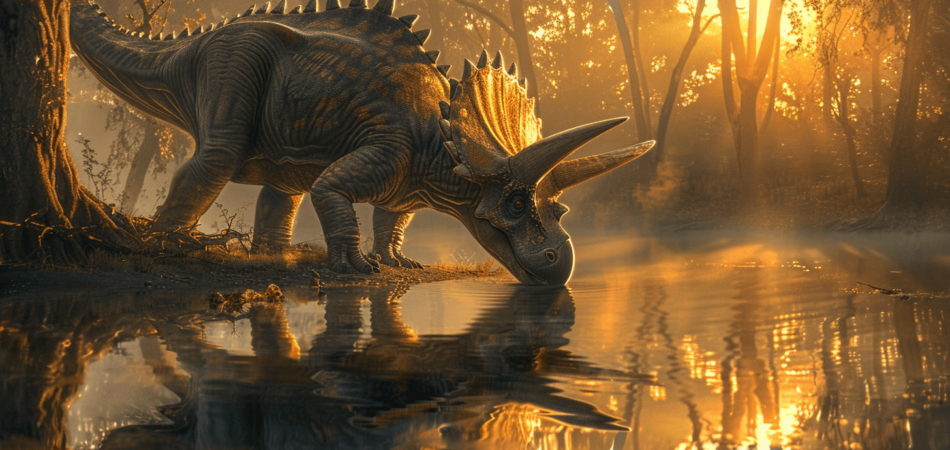
Have you ever stopped to wonder about the history and biology of an ancient creature like the Triceratops? Whether you’re a science enthusiast or simply fascinated by fossils, uncovering the mysteries surrounding this mysterious three-horned dinosaur is a fascinating experience. In this comprehensive guide, we’ll explore how the Triceratops evolved over time as well as delve into its unique physical attributes and biological structures. From their classification down to their behavior in prehistory, get ready for an educational journey that will take us deep into the heart of this amazing Cretaceous species!
A Triceratops is a dinosaur that lived approximately 68-65 million years ago during the late Cretaceous period. It is one of the most iconic dinosaurs due to its distinctive three-horned face and large frill. The name “Triceratops” comes from Greek words meaning “three-horned face.” As one of the last known non-avian dinosaurs, Triceratops was a large herbivore that roamed North America in herds. Triceratops fossils have been found all over western North America, north as Alaska, and south as Mexico. They have also been found in China and Mongolia. The largest fossilized remains are believed to be that of a Triceratops horridus, which measured up to 9 meters long and weighed up to 6 tons! This makes it the largest known member of this genus of ceratopsian dinosaurs. Triceratops are fascinating creatures for many reasons, including their sheer size and strength. Additionally, they were some of the last surviving members of their environment before the mass extinction event that wiped out most life on Earth at the end of the Cretaceous period. Their fossils provide valuable insight into how these ancient creatures lived, how they interacted with other species in their environment, and what roles they played within their ecosystem. Finally, because Triceratops were so distinctively adorned with horns and frills, they offer a unique window into our understanding of evolution and adaptive radiation within prehistoric times.
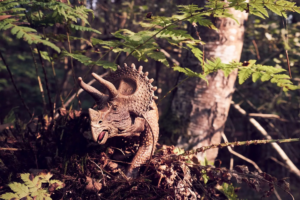
Triceratops was a type of herbivorous dinosaur that lived during the Late Cretaceous period around 65 million years ago. As one of the most recognizable dinosaurs, these large animals had three horns on their head and a large bony frill extending from the back of their skulls. They were likely very social animals and were known to have traveled in herds. Triceratops were found throughout North America, with fossils being discovered in Montana, Wyoming, South Dakota, Colorado, New Mexico, Alberta, and Saskatchewan. Triceratops inhabited floodplains and wetlands near rivers and streams. There is evidence that they may have used similar areas for grazing and nesting as many other herbivorous species do today. Fossilized footprints suggest that Triceratops didn’t move beyond their wetland habitats – they stayed in close proximity to water sources. This creature was believed to consume mainly low-lying foliage such as ferns, cycads, and palms – vegetation that would have been abundant in such an environment. Triceratops also appears to have relied heavily on visual cues for communication and protection from predators like Tyrannosaurus rex. Its facial features are thought to have served either a defensive purpose or possibly even used for courtship displays between individuals. The impressive horns atop their heads could have been used for defense against adversaries or rival herd members competing for mates or food resources. Overall, Triceratops was well adapted to its swampy habitat with its sharp beak-like mouthparts and powerful legs that allowed it to easily maneuver through thick vegetation. Its unique facial features gave it an edge when it came to communication within its own species as well as protecting itself from predators like T-rex which roamed the same areas millions of years ago.
Triceratops fossils are an incredible part of the natural world that paleontologists and other scientists have studied since they were first discovered. The first Triceratops fossil was discovered in the late 1800s. Since then, much research has gone into understanding how this dinosaur lived, died, and interacted with its environment. Triceratops’ bones are quite distinct from other dinosaurs due to their three horns and large frilled head crest, making them easily recognizable. The Triceratops horn was sheathed in an outer layer comparable to what is found on our fingernails. They were herbivores that lived in herds on the plains of North America during the Late Cretaceous Period. Scientific investigation of Triceratops specimens has revealed many fascinating facts about this dinosaur species. Through fossil analysis, researchers have determined that these animals could reach lengths of up to 9 meters (30 feet), with some estimates as high as 12 meters (40 feet) long! Additionally, it is believed that these animals had bulkier heads than Tyrannosaurus Rex, which allowed them to generate greater force when attacking or to defend themselves from predators. Studies also suggest that these formidable creatures may have lived in social groups where they would travel together for protection from predators and scavengers.
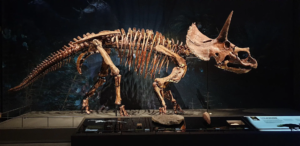
These horned dinosaurs are both fascinating and unique thanks to their impressive size, wide range of colors, and distinctive natural armor. Triceratops prorsus is a species of the genus Triceratops, one of the most well-known dinosaur genera. The Triceratops prorsus subspecies is distinguished by its larger size and longer horns compared to other triceratops species. Triceratops horridus is a species of the genus Triceratops and is distinguished by its three horns; two on its face and one at the tip of its nose. Skill generally caused triceratops bones to be jumbled up when fossilized, making it hard for paleontologists to get a clear picture of the original triceratops posture or stance, but it does not impact its undeniable visual appeal. The Triceratops skull is the complete dinosaur skull ever discovered and measures 7 feet across. Many triceratops bones have been found that are still remarkably intact and, in some cases, protected in sedimentary material as if they were embedded in some kind of triceratops time capsule.
The battle between Triceratops and T-Rex has been a topic of much debate among paleontologists for years. Both dinosaurs were apex predators in the Late Cretaceous period, and each had its own unique set of weapons for survival. Triceratops had a large body with heavy armor plating and three horns on its head. The bone structure of its neck was also designed to be able to take massive impacts from large prey or predator attacks without breaking. It was believed to have an effective means of defense against other predators such as Tyrannosaurus Rex. On the other hand, Tyrannosaurus Rex had a powerful jaw filled with sharp teeth that could do some serious damage. It is thought that it could easily outrun any dinosaur and crush whatever it happened to catch with its powerful jaws and claws. When it comes down to it, both Triceratops and Tyrannosaurus Rex would have been powerful opponents in a fight, but which one would have come out victorious? There is no definitive answer since both species were incredibly resilient in their own ways; however, some experts believe that T-Rex would have emerged victorious due to its superior speed and agility compared to the slower Triceratops. This opinion is supported by discoveries of fossilized bones showing evidence of puncture wounds consistent with those inflicted by T-Rex’s teeth. Nevertheless, there are still numerous arguments among experts, as both animals were well-armed and capable fighters in their own right.
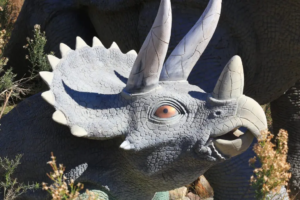
Triceratops is one of the most recognizable dinosaur species in pop culture and media, appearing in countless cartoons, books, movies, and video games. Some of the earliest appearances of Triceratops include their prominent roles in “The Flintstones” cartoon from the 1960s and the 1933 film “King Kong.” Since then, they have featured heavily in such popular franchises as Jurassic Park, where they were a favorite for children everywhere. They have also been featured prominently in video games such as Super Mario Bros. 3 and Super Smash Bros Ultimate. In addition to appearing on-screen and in video games, Triceratops has also made numerous appearances in literature. The classic book series “The Land Before Time” focuses primarily on a group of young dinosaurs led by Littlefoot (a Triceratops). In addition to this series, many other books have featured Triceratops characters or used them as symbols to represent courage or strength. The 1990 novel Jurassic Park by Michael Crichton features a variety of Dinosaurs, including Triceratops, which are seen throughout the story arc. Beyond literature and media, Triceratops is often used as an emblem of courage or strength. The United States Military even adopted it as their symbol for armored warfare during World War II because of its imposing size and mightiness. Many companies use it today as a logo or mascot to represent strength and power – often representing growth or resilience within an industry. Overall, Triceratops has had an incredible impact on our culture through its presence in media and literature over the past century. It has become an iconic symbol of strength that is recognized by people all around the world – regardless of age or generation.
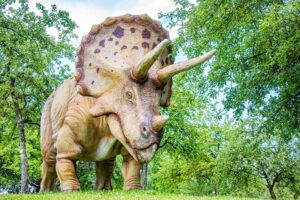
The Triceratops is one of the most iconic dinosaurs, renowned for its impressive size and weight. This large dinosaur was around nine meters in length and weighed five to eight tons. It had a tall neck frill measuring up to two meters long and a large skull measuring up to one meter in length. Its body was heavily armored with thick bony plates, making it well protected against predators. The tail of the Triceratops was long and powerful, which could be used as a whip or a battering ram to defend itself from attackers. The legs were relatively short but strong, allowing them to move swiftly when needed and maneuver quickly in tight spaces. This impressive creature had two horns atop its head which measured up to one meter long each, while the third horn above its snout was much smaller. Its diet consisted mainly of low-lying plants such as ferns and cycads, although some experts believe it may have also hunted small animals occasionally. The Triceratops lived during the late Cretaceous period and is thought to have been one of the last non-avian dinosaurs before their extinction 66 million years ago.
Triceratops was a large, plant-eating dinosaur that lived over 70 million years ago during the late Cretaceous period. It had an impressively long skull adorned with horns and frills, and its namesake name means “three horns.” As a herbivore, it spent much of its time grazing on vegetation like ferns and horsetails. It is believed that Triceratops traveled in large herds to ensure their safety from predators such as Tyrannosaurus Rex. The diet of Triceratops likely changed depending on the season and availability of food. During the drier months, it would have focused more on tougher foliage, such as cycads, palms, and conifers. During wetter seasons when these plants were unavailable, it may have shifted its diet towards softer foliage such as grasses and forbs. The presence of phytoliths (tiny fragments of silica formed from plant-based material) shows that these animals consumed both hard and soft plants as part of their diet. Triceratops teeth are truly remarkable in their design, as they were specifically adapted for the dietary needs of this large, herbivorous dinosaur. The long, curved teeth could reach up to two inches in length and were tapered to the point that was perfectly suited for cutting through dense vegetation. In fact, the teeth were constructed from materials that would bend without breaking, thus allowing them to stand up to repeated wear and tear and last through their lifetime. This simple yet effective feature allowed Triceratops to obtain vital nutrients with greater efficiency than most other types of dinosaurs in its time. Triceratops appears to have been a browser rather than a grazer; they moved around often in order to find food sources. This behavior is supported by their wide tooth shapes, which were well suited for snipping off leaves or ripping up roots rather than grinding them down as a grazer would do. The high number of cheek teeth suggests that Triceratops could easily process difficult vegetation during times when other resources were scarce.
Triceratops is one of the most well-known herbivorous dinosaurs of the late Cretaceous period. This powerful dinosaur with the three-horned face lived in herds and had an interesting social structure and behavior. They were large animals, reaching up to 30 feet long and weighing up to 12 tons. Triceratops were likely territorial and aggressive, as evidenced by their large horns and frills; these features were likely used in combat with predators or between rival males during the reproductive season. Triceratops were thought to have lived in herds comprised of several dozen individuals, mostly related females. Male ceratopsians often left their family groups during the reproductive season, presumably to find mates. Studies on modern day ungulates suggest that male Triceratops may have displayed dominant behaviors such as herding rivals away from potential mates or head-butting contests between competing males for mating rights. Young Triceratops would likely stay in their family group until they reached maturity at around five years old, at which point they might disperse and look for a mate of their own. The size of these ancient herds was difficult to measure as not many fossilized remains were discovered together; however, recent studies suggest that Triceratops may have traveled in larger groups than previously believed, with some herds numbering in the hundreds or even thousands of individuals! In addition to being a formidable predator defense mechanism, Triceratops horns and frills may have been used for other social functions, such as establishing dominance hierarchies within herd populations or signaling conspecifics during courtship displays. The presence of unusually long horn cores on some specimens suggests that at least some Triceratop species had colorful crests, which could have been used like peacock feathers – a sign of health and fitness during mating season!
Triceratops is one of the most recognizable dinosaurs, thanks to its distinctive three-horned head and bony expanded frill. As a result, it’s no surprise that it’s also one of the most popular dinosaurs featured at dinosaur parks and museums around the world. From life-sized sculptures to life-like animatronic replicas, all sorts of representations of Triceratops have been created for museum visitors to enjoy.
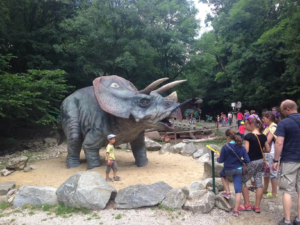
At many dinosaur parks and museums, visitors can experience what it was like to encounter a triceratops in its natural habitat by walking through recreations or simulated environments. These environments often include other dinosaurs from the same period as Triceratops, creating a more immersive experience. Some museums also feature interactive activities related to Triceratops, such as digging for fossils or playing games that educate visitors about the prehistoric creature. Triceratops remains are also often displayed in dinosaur parks and museums, allowing visitors to get a close look at the fossilized bones. In some cases, fragments of triceratops skeletons have even been pieced together by paleontologists and displayed in their completed form to give people an idea of what these creatures may have looked like when they roamed the earth millions of years ago. Overall, there are plenty of ways for people to experience and learn more about Triceratops at dinosaur parks and museums. From life-like models to interactive activities and displays of fossilized remains, these attractions provide a unique opportunity for people to gain insight into this iconic prehistoric creature.
The extinction of the Triceratops is a topic that has mystified scientists, with various theories and speculations being put forth as to why this iconic dinosaur disappeared. One popular theory suggests that the Triceratops were under pressure from changing environmental conditions and competition with other species, leading to their eventual vanishing. Another idea proposes that climate change may have led to an overall decrease in food sources, resulting in a lack of sustenance for the Triceratops population and leading to their demise. Others think that volcanic activity could have caused massive environmental disruption, leading to the extinction of the species. Whatever the case may be, it is clear that something drastic must have happened for such a large creature to suddenly disappear from the Earth’s surface. Other theories suggest that human interference might have had something to do with it; perhaps early humans hunted down populations of Triceratops and drove them into extinction. This is unlikely, though, since there is no evidence of humans living in regions where Triceratops were found during their time on Earth. It is possible that human activity, such as deforestation, might have contributed to decreased food sources or changed habitats that would not support Triceratops populations. Finally, it is also possible that some catastrophic event led to the Triceratops’ extinction. A comet impact or similar natural disaster could have wiped out this species in a very short amount of time. While there isn’t much evidence for these types of ideas, they do fit with what paleontologists know about how quickly species can be wiped out by catastrophic events like meteor strikes or major volcanic eruptions. The truth is, we will likely never know exactly what caused the disappearance of this mighty beast, but hopefully, further studies will help us uncover more details about its extinction in time.
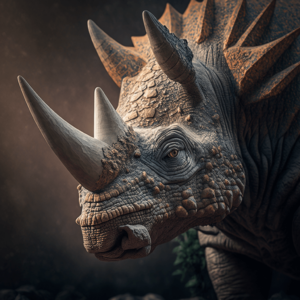
The mighty, three-horned beast has been a source of fascination throughout the ages. From its unusual breeding habits to its powerful and intimidating presence on the battlefield, the three-horned beast has been revered in many different cultures for its physical strength and agility. It is believed that these creatures were brought to life by black magic and possess some magical properties too. These unusual creatures have long been an integral part of fantasy literature and are often depicted in stories as fierce warriors with superhuman powers capable of fighting off their adversaries with just a single strike of their horns or talons. The three-horned beast is also believed to possess supernatural senses that allow it to detect danger from afar and alert those nearby with a loud roar. This characteristic makes them one of the most feared guardians in folklore and mythology. While we may not know exactly what these beasts look like, we can be certain that they are indeed majestic creatures! The three horns atop their head served as a warning to any who wished them harm while giving them an extra edge when engaging in combat. Meanwhile, their thick coats protect them against the elements while affording them flexibility when navigating difficult terrain. At the same time, these beasts are far more than just savage predators; many cultures view them as benevolent protectors who guard sacred sites or offer spiritual guidance to those they encounter. In this regard, they represent much more than mere physical might and embody noble qualities such as courage, loyalty, and wisdom. All things considered, it’s no wonder why so many people throughout history have held the mighty, three-horned beast in such high esteem – it truly is an impressive creature!